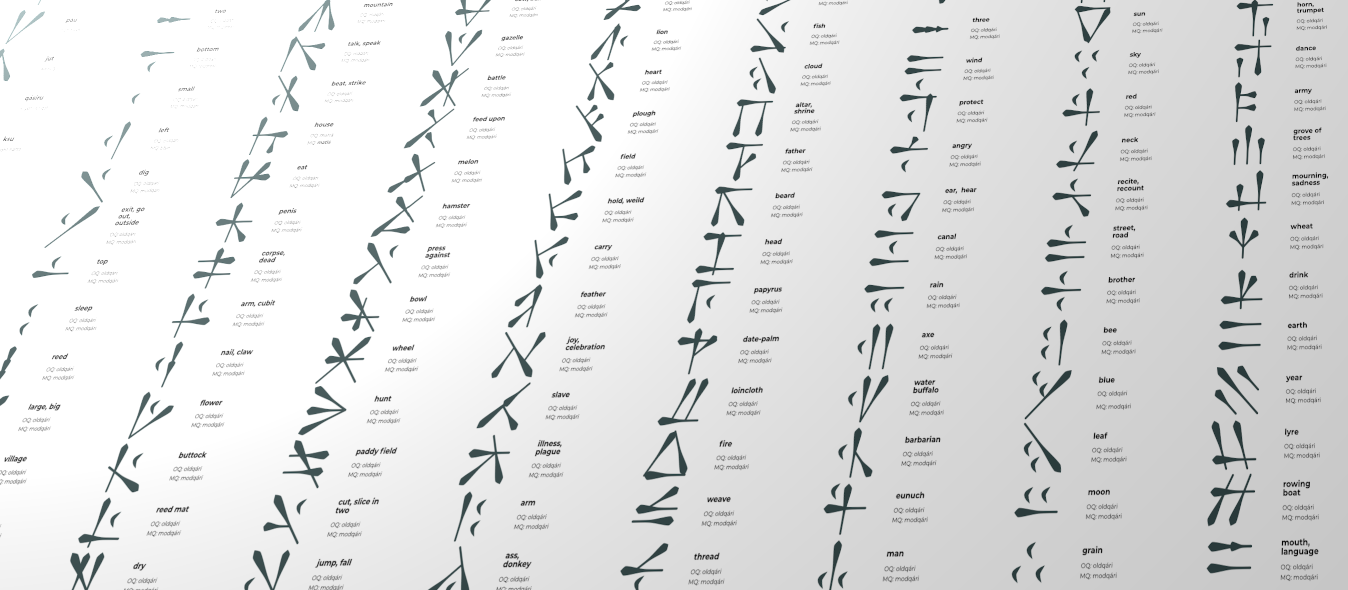Or, a brief guided tour of some of the main features of the Qári grammar. The ones I find most interesting, at least! We begin with the morphology of nouns, adjectives and pronouns.
Overall, Qári is a strongly analytical language: the amount of inflectional morphology is comparable to that of English.
Nouns inflect for number, with the singular unmarked and the form of the plural marker conditioned by the word’s animacy and (to a degree) phonetic shape. Animacy is a lexical property of a noun rather than being wholly semantically determined. For example, external body parts, fruit-bearing trees and rivers all belong to the animate class; as well as the expected animals, birds, fish and supernatural entities.
The animate plural marker is regularly –u after a consonant, and –l after a vowel. Irregular plurals are uncommon (a notable one being kaluyi, the plural of kaló ‘deity’), although there are several stem alternations to look out for. Nouns ending in –txe will generally have a plural ending in –txal (e.g. hegitxe ‘enemy’ > hegitxal ‘enemies’), and a number of nouns ending in –t or –h will change this consonant when the plural marker is added. This is primarily due to Qári’s restrictions on what consonants can appear in auslaut: for example, the plural of nóh ‘fish’ is nóqu, the substitution of h for q in the singular being due to final /kʷ/ being impermissible in Qári.
The inanimate plural markers are -(y)á and –r, with the latter being the more frequent of the two and occurring only after a vowel. However, the distribution of -(y)á is not wholly predictable synchronically, and the selection of the “wrong” suffix is a frequent error even by fluent native speakers. Inanimate irregular plurals in the Classical language are lacking, although Early Classical Qári was possessed of a large number. These have largely been eliminated by analogy, although a number of originally plural forms have since been lexicalised. For example, the current regular plural of tuhit ‘field’ is tuhitá, while the inherited “irregular” plural talatxá has come to mean ‘city hinterlands’.
The marking of number on Qári nouns operates at the level of the noun phrase rather than the noun. That is to say that if plurality is expressed elsewhere in the noun phrase, it does not appear on the noun. Consider qánil ‘puppies’ but qáni rató ‘many puppies’, with the head noun lacking plural marking.
Where a generic referent or referents is intended by the speaker, plural marking is also absent. Unlike English, Qári does not use the plural to indicate non-specificity. Compare the two sentences below:
tósi nédiru. tósi nédir.
stupid slave-PL | stupid slave
“Some slaves are stupid.” “Slaves (in general) are stupid.”
In the first, the speaker is considering a specific group or subset of slaves. In the second, the speaker is considering slaves as a class.
Appositive adjectives may inflect for number and definiteness, with both sets of markers exhibiting concord with the head noun’s animacy. The unmarked position for adjectives is after the noun.
Only postnominal adjectives mark number, with adjectives qualifying animate nouns indicating plurality with –l and those qualifying inanimate nouns with –yá. As mentioned above, plurality is only marked once in a noun phrase, and there is a strong tendency for the locus of plural marking to gravitate towards the rightward edge of the phrase. Thus:
nédir tósi. nédir tósil. nédir tósi rató.
slave stupid | slave stupid-PL | slave stupid many
“A stupid slave.” “Stupid slaves.” “Many stupid slaves.”
Adjectives qualifying a definite noun will precede the head and take markers for definiteness. The animate definite marker is –t and the inanimate is –ye:
at nédir. at nédiru. tósit nédir. tósit nédiru.
DEF slave | DEF slave-PL | stupid-DEF slave | stupid-DEF slave-PL
“The slave.” “The slaves.” “The stupid slave.” “The stupid slaves.”
The definite form, when post-nominal, also serves as the superlative form:
nédir tósit. at nédir tósit. at nédir tósitu
slave stupid-DEF | DEF slave stupid-DEF | DEF slave stupid-DEF-PL
“A most stupid slave.” “The most stupid slave.” “The most stupid slaves.”
The personal pronouns of Qári are as follows:
| singular | plural | |
| 1st person | já | dijá |
| 1st and 2nd person | ná | maná |
| 2nd person | rá | hará |
| 3rd person proximate | sót (an), sóye (inan) | sól (an), sóyá (inan) |
| 3rd person obviative | dut (an), duye (inan) | dul (an), duyá (inan) |
| 3rd person indefinite | ló | ló |
The first person plural dijá is exclusive of the interlocutor. The pronoun ná essentially indicates ‘you and I’, while the plural form maná is ‘you, I and others’. The pronoun ná is also used as an intimate second person pronoun, much as how in English one might say “how are we today?”, but without the patronising connotation.
The third person proximate and obviative pronouns are transparently aphaeretic forms of the demonstrative adjectives pésó ‘this’ and gidu ‘that’, and so they inflect like definite adjectives in the singular and appositive adjectives in the plural.
Coming up in part 2: prepositions and verbal morphology.
